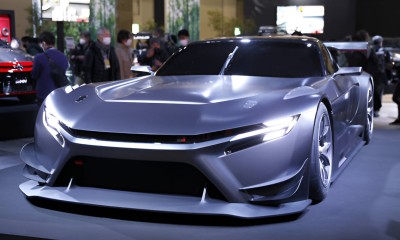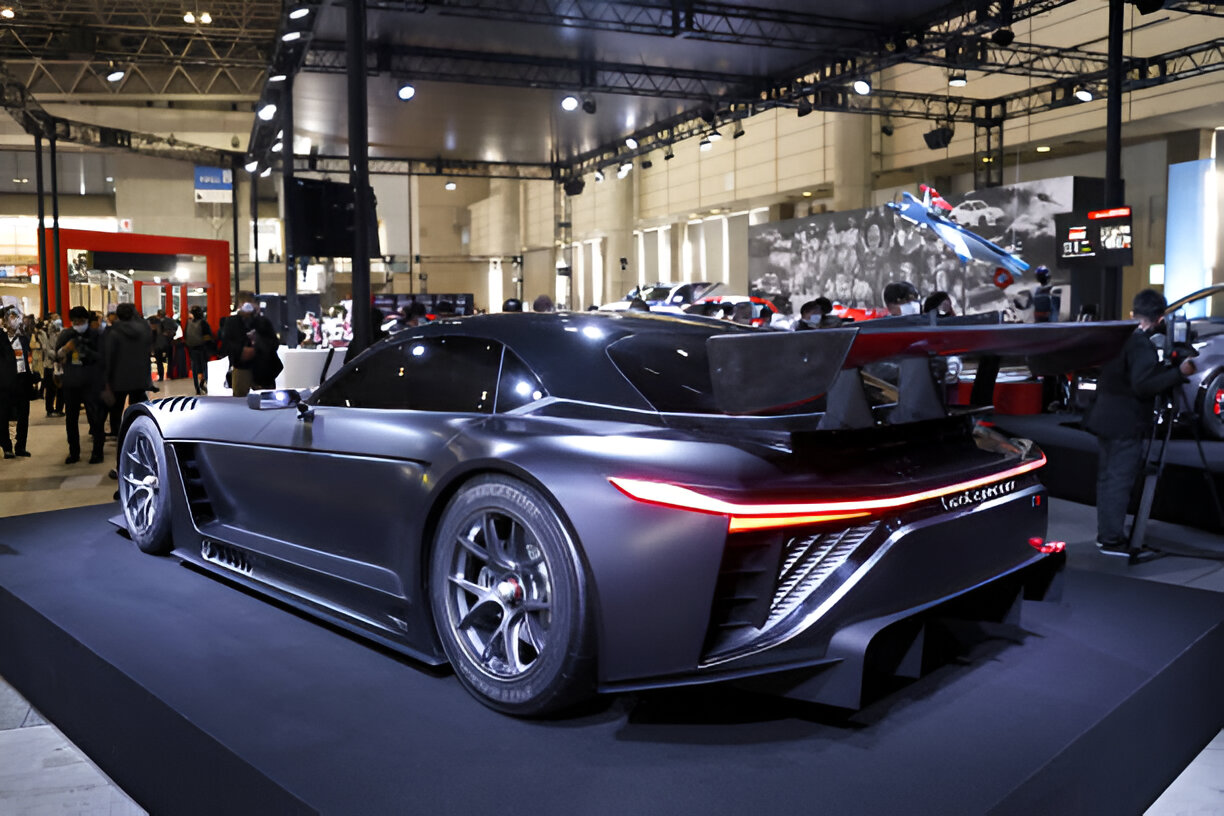Toyota GR GT3: A Technical Deep Dive into Motorsport ECU Calibration and Performance

The world of international sports car racing is on the cusp of a significant shift, heralded by the arrival of a formidable new contender: the Toyota GR GT3. This machine is far more than just a new car; it represents a fundamental change in Toyota's high-performance vehicle development strategy. By prioritizing the race car's development ahead of its road-going counterpart, Toyota Gazoo Racing (TGR) is crafting a vehicle with an uncompromised performance architecture, engineered from the ground up for a single purpose: victory.
From Concept to Competitor: A "Motorsports-Bred" Philosophy
The journey of the GR GT3 began with its stunning global debut as a concept at the 2022 Tokyo Auto Salon. From the outset, TGR's official communications made its intentions clear. The project's goal was to "commercialise motorsports cars rather than simply adapting production vehicles for use in motorsports," a philosophy already proven successful with the acclaimed GR Yaris. This approach marks a complete reversal of the traditional homologation process, where a manufacturer modifies an existing road car for competition. Instead, the GR GT3 race car is the genesis, and its road-legal version—expected to be badged as the Lexus LFR will be its direct descendant.
This "race car first" methodology is not merely a marketing slogan but a profound paradigm shift in research and development. It ensures that every core engineering decision from chassis rigidity and suspension geometry to engine placement and aerodynamic profiling—is dictated by the uncompromising demands of motorsport. The result is a platform optimized for the track from its very inception, free from the compromises inherent in adapting a mass-production vehicle. The GR GT3 is scheduled for its competitive debut in 2026, with the iconic Rolex 24 at Daytona being the likely venue, while the road car is anticipated to follow in 2027.
Engineering the Apex Predator: Chassis and Aerodynamics
The GR GT3's form is a pure expression of its function. It features a classic front-mid-engine, rear-wheel-drive layout, characterized by a long bonnet and a dramatically swept-back cabin to optimize weight distribution and aerodynamic efficiency. Its silhouette is a radical departure from any current Toyota or Lexus model, underscoring its purpose-built nature. 
This clean-sheet design stands in stark contrast to the Lexus RC F GT3 it is set to replace. The outgoing model was fundamentally constrained by the production RC F's monocoque, which limited critical factors like engine mounting position and overall dimensions. The GR GT3 suffers no such limitations. This engineering freedom has allowed TGR to craft a chassis with a significantly lower center of gravity and wrap it in bodywork where every surface is honed for aerodynamic performance. Spy shots and concept imagery reveal a suite of aggressive aerodynamic devices, including a massive front splitter, functional bonnet vents, a side-exit exhaust, a prominent rear wing, and a complex multi-channel diffuser—all essential components for generating the immense downforce required in modern GT3 racing. The structure is expected to consist of a lightweight aluminum chassis enveloped in carbon fiber body panels, a direct application of the "knowledge and refined technologies TGR has gained in the field of motorsports".
Powertrain Analysis: The V8 Heart and Hybrid Future
The auditory evidence from numerous trackside test sessions, combined with insider reports, overwhelmingly confirms that the heart of the GR GT3 is a V8 engine, widely believed to be a twin-turbocharged unit. While the race car's ultimate power output will be strictly regulated by Balance of Performance (BoP) rules to a competitive window of approximately 500-600 horsepower, the platform's true potential will be unleashed in the road-going Lexus LFR.
Rumors suggest the LFR will feature a formidable hybrid powertrain. A 4.0-liter twin-turbo V8, producing around 720 horsepower on its own, is expected to be augmented by a self-charging hybrid system, culminating in a staggering combined output of approximately 900 horsepower. This positions the vehicle to compete directly with the latest generation of hybrid supercars from European marques like Ferrari and Lamborghini. The engine itself is likely a heavily modified evolution of an existing Lexus V8 architecture, such as the 2UR-GSE, re-engineered for the extreme demands of this new application.
|
Feature |
Toyota GR GT3 (Race Car) |
Lexus LFR (Road Car - Rumored) |
|
Engine Type |
Twin-Turbo V8 |
Twin-Turbo V8 |
|
Displacement |
~4.0L - 5.2L |
~4.0L |
|
Aspiration |
Twin-Turbocharged |
Twin-Turbocharged |
|
Hybrid System |
No (per GT3 rules) |
Yes (Self-Charging Hybrid) |
|
Peak Power (Combustion) |
~500−600 hp (BoP dependent) |
~720 hp |
|
Peak Power (Combined) |
N/A |
~900 hp |
|
Chassis |
Aluminum/Carbon Fiber Composite |
Aluminum/Carbon Fiber Composite |
|
Primary Mission |
FIA GT3 Competition |
Halo Supercar / LFA Successor |
|
Debut |
2026 |
2027 |
Redefining "Tuning" in the World of GT3 Racing
For enthusiasts and professionals accustomed to road car modification, the term "tuning" is synonymous with unlocking more power. However, in the highly regulated and fiercely competitive arena of GT3 motorsport, this definition is turned on its head. Here, tuning is not about maximizing horsepower; it is a complex science of precision, compliance, and strategic optimization within a rigid framework designed to ensure parity.
The Regulatory Framework: An Introduction to Balance of Performance (BoP)
Unlike a road car, a GT3 machine like the Toyota GR GT3 is not tuned to its mechanical limits. Instead, its performance is meticulously governed by a system known as Balance of Performance (BoP). Pioneered by the SRO Motorsports Group and now a cornerstone of GT racing worldwide, BoP is a set of dynamic technical adjustments applied to level the performance potential across a diverse grid of cars. Whether a car is front-engined or mid-engined, turbocharged or naturally aspirated, BoP aims to ensure that no single design philosophy confers an insurmountable advantage.
This system is critical to GT3's global success, as it promotes close, unpredictable racing and prevents a "development arms race" where budgets, not skill, dictate the winner. For major international championships like the(
https://www.fiawec.com/), governing bodies like the FIA and ACO jointly establish the BoP tables, using a vast pool of data gathered during homologation, wind tunnel analysis, dyno testing, and on-track performance monitoring. This regulatory environment fundamentally redefines the objective of engine calibration. The goal shifts from extracting maximum power to achieving perfect compliance with the mandated performance window, while simultaneously optimizing drivability, fuel efficiency, and reliability
within those strict constraints. It is a far more nuanced and data-intensive engineering challenge than simply chasing peak horsepower.
The ECU: The Digital Arbiter of Performance
The primary instrument for enforcing these complex BoP regulations is the Engine Control Unit (ECU). In GT3 racing, the ECU is not a component that teams can freely modify or re-flash. Instead, it operates on locked, homologated software that contains the specific, mandated performance parameters for that car at that event.
High-level motorsport overwhelmingly relies on advanced, standardized ECUs, such as the Bosch Motorsport MS 7 series, for this critical task. These powerful units are chosen for their immense processing power, hardware flexibility, and, most importantly, their security and data-logging capabilities. A modern motorsport ECU can precisely manage complex systems like direct fuel injection, variable valve timing, and multi-stage traction control, all while logging hundreds of channels of data for post-session scrutineering. The ECU thus becomes the central nervous system of the car and the digital gatekeeper through which BoP is precisely and unflinchingly enforced. This shift underscores a critical trend in high-performance engineering: control is migrating from hardware modification to sophisticated software calibration.
A Technical Analysis of GT3 ECU Management and BoP Implementation
To truly appreciate the concept of Toyota GR GT3 tuning, one must understand how Balance of Performance is applied at a granular level. The ECU acts as the digital enforcer for a multi-faceted strategy designed to equalize performance across the grid. This is achieved through the precise management of three key pillars.
The Three Pillars of Performance Balancing
BoP adjustments are not arbitrary; they are targeted interventions designed to manage a car's inherent strengths and weaknesses. These are primarily controlled or monitored through the ECU and its network of sensors.
-
Engine Power & Torque Limitation: For a turbocharged engine like the V8 in the GR GT3, the BoP tables will dictate a highly specific boost pressure curve that maps target boost against engine RPM. The ECU is programmed to follow this curve with absolute precision. The onboard data logger constantly monitors this, and any deviation—an "overboost" condition lasting even for milliseconds—is flagged and immediately reported to race stewards for investigation and potential penalties. For naturally aspirated engines, physical air restrictors are used to limit airflow, but the ECU's control over the lambda value (air-fuel ratio) is also fixed to prevent teams from running dangerously lean mixtures to find extra power.
-
Minimum Weight & Ballast: Each car model is assigned a minimum racing weight. To balance the field, BoP ballast (additional weight) is strategically added to cars deemed to have a performance advantage, thereby equalizing their power-to-weight ratios. While this is a physical change, the decision to apply ballast is data-driven, relying on performance metrics recorded by the ECU's data logger during practice and qualifying sessions.
-
Aerodynamic Configuration: While settings like minimum ride height and maximum rear wing angle are physical adjustments, their overall effectiveness is inextricably linked to the power delivery managed by the ECU. A team must find the optimal aerodynamic compromise between low drag for high top speeds on the straights and high downforce for grip in the corners, all while operating within the power and torque curves dictated by the ECU's BoP map.
|
BoP Parameter |
Performance Impact |
ECU/Digital Enforcement Method |
|
Turbo Boost Pressure |
Directly controls engine torque and horsepower output across the rev range. |
The ECU enforces a mandated boost pressure curve. The sealed data logger constantly records actual boost vs. target boost and flags any deviations. |
|
Lambda (Air/Fuel Ratio) |
Affects power output, engine response, and fuel efficiency. |
The ECU operates on a fixed lambda target map. Fuel-saving maps that alter this ratio beyond approved limits are disallowed. |
|
Minimum Weight / Ballast |
Affects acceleration, braking efficiency, cornering grip, and tire degradation. |
The ECU's data logger provides the raw performance data (lap times, sector times, acceleration rates) that race officials use to assign or adjust BoP ballast. |
|
Fuel Capacity / Flow Rate |
Determines the maximum length of a racing stint and influences overall race strategy. |
The ECU's data is used to monitor fuel consumption rates. Some series employ ECU-linked fuel flow sensors for real-time monitoring. |
|
Ride Height / Wing Angle |
Manages the aerodynamic balance between straight-line speed (low drag) and cornering capability (high downforce). |
While these are physical settings, their performance is analyzed against ECU-logged data (e.g., speed, g-forces) to assess their effectiveness and inform future BoP adjustments. |
The Unseen Race: Data Logging and Scrutineering
Every GT3 car is fitted with a mandatory, sealed data logger that is the property of the race organizer. This "black box" records hundreds of channels of data, from critical engine parameters and sensor readings to GPS location and g-forces. After every on-track session, officials download this data and compare it against the car's prescribed BoP window. In series like the(
https://www.imsa.com/weathertech/), sophisticated tools like the Bosch Scrutineering System are used to automate this analysis, quickly identifying any anomalies. This constant, data-driven surveillance makes non-compliance with BoP regulations virtually impossible to conceal.
Inside the Cockpit: Driver-Selectable ECU Maps
Even within the rigid confines of BoP, drivers and engineers retain a degree of strategic flexibility through pre-approved, selectable ECU maps. These maps do not increase the car's maximum legal power output. Instead, they alter the engine's characteristics—such as throttle response and fuel delivery—to suit different situations. Common maps include:
-
Qualifying Maps: These deliver the maximum legal power with the most aggressive throttle response for single-lap performance.
-
Race Maps: These offer a balanced profile, blending strong performance with manageable fuel consumption for race stints.
-
Fuel-Saving Maps: When strategy calls for extending a fuel stint, these maps slightly reduce power and soften throttle response to conserve fuel.
-
Wet-Weather Maps: In slippery conditions, these maps provide a much more progressive throttle response to help the driver manage traction.
Alongside these engine maps, drivers have multi-stage, adjustable traction control (TC) and ABS systems, allowing them to fine-tune the car's behavior as tires wear and track conditions evolve. This strategic use of different software calibrations in a high-stakes environment provides a perfect analogue to the value offered by professional road car tuning.
From Racetrack to Workshop: Applying Motorsport Principles to Commercial ECU Tuning
The sophisticated world of motorsport calibration, with its focus on data, precision, and reliability, may seem distant from the day-to-day operations of a tuning workshop. However, the core principles are identical. The same data-driven methodology used to optimize a Toyota GR GT3 for Le Mans can be applied to enhance the performance of a customer's road car.
Beyond Factory Limits: The Core of Professional Chiptuning
A direct parallel can be drawn between the two disciplines. Motorsport engineers meticulously calibrate an ECU to operate flawlessly within the strict BoP window. In the commercial world, expert tuners at HP Chiptuningfiles recalibrate a production vehicle's ECU to operate safely and reliably beyond the manufacturer's conservative factory settings.
The fundamental knowledge required is the same: a deep, scientific understanding of engine control strategies, including torque targets, ignition timing maps, air-fuel ratios, and boost control logic. While the manufacturer tunes for a wide range of global conditions, emissions standards, and driver profiles, a professional chiptuning service unlocks the engine's true, engineered potential for a specific market and use case.
A Data-Driven Approach: How Professional Tuning Files Are Developed
Professional chiptuning files are not created through guesswork; their development is a rigorous scientific process that mirrors the R&D of a race team.
-
Baseline Analysis: The process begins by reading the vehicle's original ECU file and establishing its baseline performance on a chassis dynamometer.
-
Parameter Optimization: Expert calibrators then methodically adjust key software maps—targeting boost pressure, fuel injection quantity and timing, ignition advance, and electronic torque limiters—based on extensive research and development.
-
Data Logging & Dyno Testing: Throughout the process, engine parameters are continuously logged and analyzed. The vehicle undergoes numerous dyno runs to verify that every change is delivering the expected performance gains safely and reliably. This iterative, data-driven cycle is identical in principle to the method used to develop and validate BoP maps for a car like the GR GT3.
The following table makes the connection explicit, demonstrating how the high-level principles of motorsport are directly applied in the development of high-quality commercial tuning files.
|
Motorsport Principle |
HP Chiptuningfiles Application |
|
Objective |
Adhere to strict BoP regulations for competitive parity and maximum reliability under race conditions. |
|
Process |
Extensive data logging, dynamometer testing, and iterative parameter analysis to match a performance target. |
|
Key Parameters |
Mandated boost curves, fixed lambda targets, engine torque limits, traction control settings. |
|
Tools |
Advanced, standardized ECUs (e.g., Bosch MS 7), proprietary calibration and data analysis software. |
|
Outcome |
A fully compliant, optimized, and reliable race car capable of competing at the highest level. |
Why HP Chiptuningfiles is Your Partner for Motorsport-Grade Performance
Understanding the intricate relationship between software, hardware, and performance is what separates the best from the rest. The same principles that allow a team to extract every ounce of compliant performance from the Toyota GR GT3 are what we apply to every file we develop.
Precision, Reliability, and Tested Results
At HP Chiptuningfiles, we deliver more than just power; we deliver confidence. Every one of our tuning files is custom-developed and rigorously tested on our state-of-the-art dynamometer. This commitment to a data-driven process ensures that all performance gains are achieved safely, respecting the mechanical limits of the vehicle's components. It's this dedication to quality and reliability that has earned us the trust of over 4,000 clients worldwide.
Deliver proven performance. Explore our tuning file database and see the difference data-driven development makes.
A Comprehensive Toolkit for Your Business
We provide a complete ecosystem for tuning professionals. Our services extend beyond our vast database of files for petrol, diesel, and hybrid engines. We offer a curated selection of high-quality tuning hardware and a streamlined B2B portal designed to make sourcing reliable files and tools effortless for workshops and dealers. We are more than a supplier; we are a partner in your success.
Equip your workshop with the best. From files to hardware, we provide the tools you need to succeed.
Frequently Asked Questions (FAQ)
1. What engine is in the Toyota GR GT3? The Toyota GR GT3 is confirmed to use a V8 engine, which is widely reported to be a twin-turbocharged unit developed specifically for racing by Toyota Gazoo Racing. For competition in FIA-sanctioned GT3 series, its power will be regulated by Balance of Performance rules to a window of approximately 500-600 horsepower to ensure competitive parity.
2. Can you tune a GT3 race car? Tuning a GT3 car is fundamentally different from tuning a road car. You cannot increase its maximum horsepower beyond the limits set by the Balance of Performance (BoP) regulations. "Tuning" in the GT3 context refers to the precise calibration of the engine, chassis, and aerodynamics to perfectly match the mandated BoP parameters while optimizing for drivability, fuel strategy, and specific track conditions.
3. How does ECU remapping increase engine performance? ECU remapping, or chiptuning, involves modifying the software on a vehicle's Engine Control Unit. Professional tuners optimize parameters that are set conservatively by the manufacturer, such as fuel injection timing, ignition advance, boost pressure, and torque limiters. By recalibrating these maps, it's possible to safely unlock significant performance reserves, resulting in substantial gains in both horsepower and torque.
4. Are HP Chiptuningfiles' files safe for my customers' vehicles? Absolutely. Safety and reliability are our top priorities. Every tuning file provided by HP Chiptuningfiles is custom-developed and rigorously tested on a dynamometer. This scientific, data-driven approach ensures that all performance enhancements are achieved well within the safe mechanical tolerances of the vehicle's engine, transmission, and drivetrain components. We provide power you can depend on. For more information, please contact us.
Other news and updates

Read more OBD Breakthrough: Tuning Support for the Continental ASG1 ECU in Audi e-tron & Porsche Taycan
The Continental ASG1 ECU used in the Audi e-tron and Porsche Taycan is now fully supported for OBD read/write. This breakthrough allows safe tuning of torque limits, current maps, thermal strategies and pedal response, enabling measurable performance gains whi...
Read more

Read more Stage 1, Stage 2, and Stage 3 Tuning: Which One Is Right for You? | HP Chiptuning Files Europe & UK
Discover the differences between Stage 1, Stage 2, and Stage 3 tuning. Learn which remap is best for your car, driving style, and budget at hp-chiptuningfiles.com.
Read more

Read more Mercedes-AMG G63 2025: ECU Remap & Performance Boost
Hey, we are HP Chiptuningfiles – Europe’s leading ECU tuning file service provider. We deliver custom, dyno-tested tuning files for diesel, petrol & hybrid engines, trusted by 4,000+ clients worldwide. The 2025 Mercedes-AMG G63 combines iconic G-Class ruggedne...
Read more